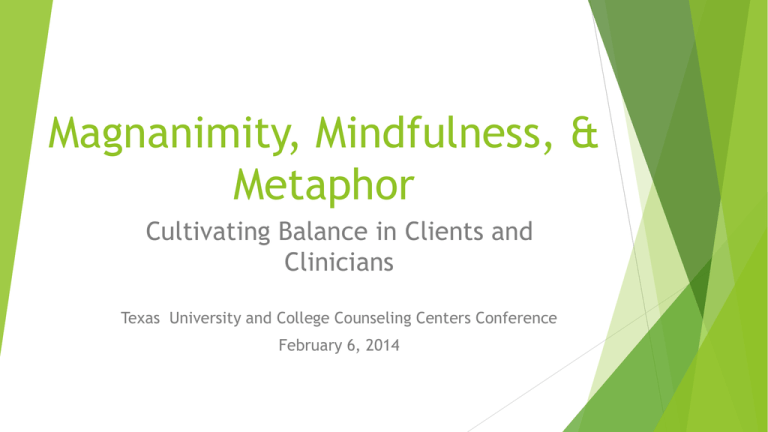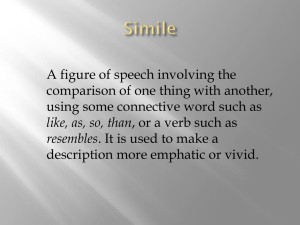Mindfulness, Metaphor, & Magnanimity
advertisement

Magnanimity, Mindfulness, & Metaphor Cultivating Balance in Clients and Clinicians Texas University and College Counseling Centers Conference February 6, 2014 Magnanimity Means “greatness of soul” Greatness results from exemplification of all virtues Virtue = mean between two extremes GREATNESS OF SOUL IS BALANCE! This is what both clinicians and clients should aim for! Metaphor and mindfulness embody balance and can therefore help us achieve and maintain equilibrium Metaphor as liaison between visceral and cerebral man Metaphor: Theory & Research CS Lewis Myth as balance between abstract and concrete Balance between world of intellect and world of experience Metaphor may be fundamental to the way we experience and think Cognitive experiential self theory1,2 Grounded cognition3 and embodied cognition4 Conceptual metaphor5 Bridge between cognition and experience Deeper level of processing Metaphor: Client Care Applications Metaphor as a vehicle for change 4 Phases/Stages 1. Enter the client’s metaphoric imagination 2. Explore client’s metaphoric imagination 3. Transformation of client’s metaphoric image 4. Connect metaphoric patterns and life problems Buffer and bridge for approaching hard material Art therapy, play therapy Clinical examples Metaphor: Self-Care Discussion Chess match/ chess master Dance/ dance partner Journey/ fellow traveler Saving the world/ superhero Change Process Metaphor The metaphor for how one conceptualizes the change process naturally affects and influences the therapists sense of and perceived need for self-care Superhero vs. journey Burnout Compassion fatigue Mindfulness “Paying attention on purpose, in the present moment, and nonjudgmentally” 6 Psychological, neurobiological, physical, interpersonal Increases awareness of bodily sensations, thoughts, emotions; unhelpful ways of coping with stress (avoidance, fusion) Fosters curiosity, acceptance, interconnectedness Rooted in Buddhist meditative disciplines Mindfulness Can be taught and practiced (neural plasticity) Mindfulness-based approaches: MBSR, MBCT, DBT, ACT Clients (i.e., ↓depression, anxiety, psychosis, PTSD, OCD, ↑ pain tolerance, PA)7 Therapists-in-training (↓ stress, NA, anxiety; ↑PA, self-compassion) 8 Clinician/self as instrument: client outcomes of mindful therapists-in-training (↓ anxiety, anger, somatization, obsessiveness, paranoia)9 Mirror neuron systems may enhance empathy Mindfulness fosters intrapersonal attunement which may, in turn, enhance interpersonal attunement Mindfulness Applications Experiential exercises How do we know when we’re feeling out of tune? Body Scan “Leaves on a stream” How do we know how to proceed? How do we sustain our instrument? “Retirement party” Discussion, Questions, Thoughts? Justine Grosso Justine_Grosso@Baylor.edu Matt Breuninger Matt_Breuninger@Baylor.edu References Epstein, S. (1994). Integration of the cognitive and the psychodynamic unconscious. American Psychologist, 49, 709-724. 1 Epstein, S. (1998). Cognitive-experiential self-theory: A dual process personality theory with implications for diagnosis and psychotherapy. In R. F. Bornstein & J. M. Masling (Eds.), Empirical perspectives on the psychoanalytic unconscious (Vol. 7, pp. 99-140). Washington, DC: American Psychological Association. 2 3 Barsalou, L. W. (2010). Grounded cognition: past, present, and future. Topics in Cognitive Science, 2(4), 716-724. 4Wilson, A. D., & Golonka, S. (2013). Embodied cognition is not what you think it is. Frontiers in psychology, 4. 5Wickman, S. A., Daniels, M. H., White, L. J., & Fesmire, S. A. (1999). A “primer” in conceptual metaphor for counselors. Journal of Counseling & Development, 77(4), 389-394. 6Kabat-Zinn, J. (1990). Full Catastrophe Living. Using the Wisdom of Your Body and Mind to Face Stress, Pain, and Illness. New York, NY: Random House. 7Hofmann, S. G., Sawyer, A. T., Witt, A. A., & Oh, D. (2010). The effect of mindfulness-based therapy on anxiety and depression: a meta-analytic review. Journal of Consulting and Clinical Psychology, 78(2), 169-183. 8Shapiro, S. L., Brown, K. W., & Biegel, G. M. (2007). Teaching self-care to caregivers: Effects of mindfulness-based stress reduction on the mental health of therapists in training. Training and Education in Professional Psychology, 1(2), 105-115. 9Grepmair, L., Mitterlehner, F., Loew, T., & Nickel, M. (2007). Promotion of mindfulness in psychotherapists in training: Preliminary styudy. European Psychiatry, 22, 485-489. 10Wise, E. H., Hersh, M. A., & Gibson, C. M. (2012). Ethics, self-care and well-being for psychologists: Reenvisioning the stress-distress continuum. Professional Psychology: Research and Practice, 43(5), 487494.







